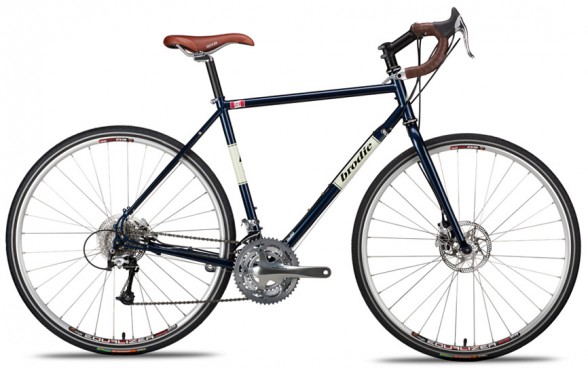What Kind Of Bike Is Best For Bicycle Touring?
Is there a special type of bike used for bicycle touring? Or can you use any type of bike for long-distance touring? Can you use a road bike for bicycle touring? Or a mountain bike?
The truth is, almost any type of bicycle can be used for bicycle touring, but the longer the bicycle tour, the more important it becomes to use a proper touring bike.
A touring bicycle, as its name suggests, is a type of bike made specifically for long-distance bicycle touring… and there are a number of different types of touring bicycles on the marketplace.
While many touring bicycles look similar to the road or mountain bike models you are likely used to, there are actually are a number of small differences that make a touring bicycle better equipped for long-distance riding.
Here, for example, are some of the features that almost all touring bikes have in common:
- Touring bicycles have wider tires than road bikes, enabling them to support more weight and ride in rougher conditions. Most touring bikes are designed to be ridden on paved roads, but can also handle a fair amount of off-road riding.
- Touring bikes are usually made of heavy-duty steel. Because touring bikes need to carry more weight, they need to be made of stronger materials.
- Many touring bikes have extremely low gears so you will have an easier time climbing hills and mountains while carrying a heavy load.
- Touring bike makers know that you are going to be spending a long time in the saddle, so they design the bikes to be more comfortable on your back, butt, hands and neck. On a touring bike you are in a more upright position than you would be on a traditional road or mountain bicycle.
- Touring bikes are also built to support racks on the front and back of the bicycle, allowing you to carry up to four panniers (or bags) on your bike at a time.
There are a bunch of other little features that make touring bikes better suited for bicycle touring adventures, but it should be noted that the bicycle you select for your travels is the most important piece of bicycle touring gear you’ll ever need to purchase.
Pick the right bicycle for your trip and you’ll be sure to come home with those wonderful bicycle touring memories you’ve been dreaming about. But pick the wrong bicycle – a bicycle that wasn’t built for the kind of bike tour you were participating in – and your bike tour might come to an end a whole lot sooner than you had hoped for.
If you read “The Essential Guide To Touring Bicycles” before you make your bicycle purchase, you can be certain you’ve purchased the best touring bike for your specific needs.


Darren,
I have become an avid follower of bicycle touring pro.com. Let me tell you we’re I am right now. I’m a 57 year old NASA engineer with a love of cycling since 12 (newspaper delivery boy in those days) As you can probably imagine I also a self thought bicycle mechanic. I’ve done several centuries and my only experience in touring has been a 6 day ride start in no in Pittsburgh all the way done to Washington, DC. This is on of the classic rides here on the East Coast- The Great Alleghanys Passage and the C&O Canal. So you figure, this is my passion.
Before I found your body of work, I’ve spent some time building custom bikes. The masterpiece is a black Surly LHT with Surly racks front and rear. I can’t send you a picture if your interested. I have a question for a man that has pedaled so many miles. This bicycle clue has not been broken-in properly and my brakes are cantilever. We both know that disc brakes have greater stopping power. I’ve noticed that sometimes, without load the bike has some latency in coming to a complete stop. Since you’ve had both and loaded, can you still maneuver and stop properly w it’s the cantilever brakes?
Would li ke to know your impression since you have experience on the field.
Yes, disc brakes are becoming more popular in the bicycle touring world, but cantillever brakes are still used and I don’t think they will be going away anytime soon. The reason cantinleve brakes are used to often on touring bicycles is because, while they are less powerful than disc brakes, they are easier to fix and find replacements for when you are traveling anywhere in the world. As I discuss inside “The Essential Guide To Touring Bicycles,” this is extremely important – if you are planning a bike tour in a part of the world where disc brakes and other bicycle parts might be difficult or impossible to find. But if you are doing most of your cycling in the United States or other developed countries, then riding with disc brakes is not only acceptable, but also a good idea.
Based on what you’re telling me, it sounds like you have a perfectly good touring bicycle in your possession… and I wouldn’t worry too much about changing to disc brakes – just because myself and so many others traveling by bike now have them. What you have is fine. Keep using what you’ve got until YOU decide that it is no longer what you want.
I think your point about this being really an issue on longer, more extensive trips is well taken. I wouldn’t want to try to cross Texas on a single speed Walmart bike, but getting out and riding is the important thing.
I have a semi-recumbent, or crank forward (Day 6 Dream) and a mountain/cruiser hybrid. Both ride very well. I have front panniers on the Day 6, and both have the hitch for my two-wheel bike trailer. I really wouldn’t hesitate to extensively tour with the Day 6, but I’d take either of them for the one or two week trips you mention that are the most common type of touring.
The important thing is to get out there!
Love your videos. Keep up the good work!